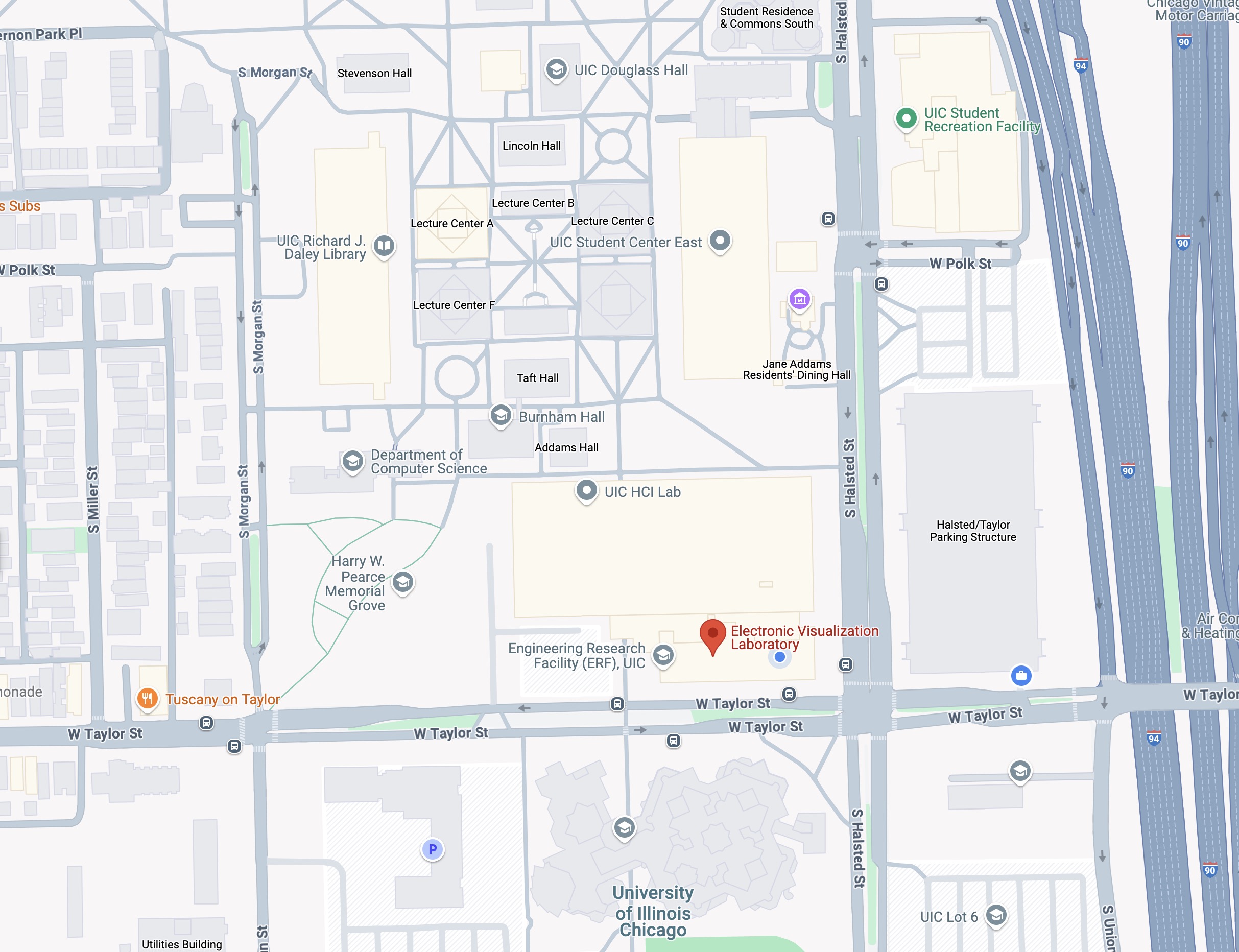EVL
Electronic Visualization Laboratory
Established in 1973 by Tom DeFanti and Dan Sandin, the Electronic Visualization Laboratory (EVL) is a pioneering interdisciplinary research laboratory in the Computer Science department at the University of Illinois at Chicago (UIC) College of Engineering. Initially named the Circle Graphics Habitat, reflecting UIC’s original designation, the laboratory has continuously specialized in collaborative visualization, virtual reality, visual data science, and advanced computing and networking infrastructure. EVL is known for consistently looking 10-15 years into the future and has built a significant legacy of innovation.
In the 1970s, the lab pioneered real-time interactive graphics and videogame technology, developing groundbreaking tools such as the GRASS programming language and the Sandin Image Processor, which facilitated real-time video and animation. Notably, EVL technology contributed to iconic film imagery, including Larry Cuba’s wireframe animation of the Death Star for the original “Star Wars” film.
In the 1980s, EVL shifted focus to scientific visualization and introduced innovations such as the Sayre Glove—one of the earliest data gloves for virtual interaction—and PHSColograms, autostereoscopic holograms enabling 3D visualization without special glasses.
Throughout the 1990s, EVL became internationally renowned for its advances in virtual reality and high-speed networking infrastructure. Key developments included the invention of the influential CAVE™ virtual-reality environment, the ImmersaDesk™, the Infinity Wall, and significant contributions to grid computing initiatives like I-WAY. EVL also spearheaded critical networking initiatives such as STAR TAP and StarLight, connecting international scientific communities with high-speed networking.
During the 2000s, EVL further expanded its innovations, developing technologies to access, share, and display ultra-high-resolution imagery on tiled display walls, including the OptIPortal and the SAGE™ (Scalable Adaptive Graphics Environment). More recent advancements from the 2010s onward include the CAVE2™ hybrid-reality environment and collaborative visualization systems such as SAGE2™ and SAGE3™ (Scalable Amplified Group Environments).
From early collaborations with artists to today’s global partnerships with scientists and engineers in academia, government, and industry, EVL has nurtured and expanded user communities, fostering interdisciplinary research and application. Its faculty, staff, and students consistently publish in prestigious journals and conferences worldwide.
EVL’s work continues to be supported by various organizations, including the National Science Foundation (NSF), National Institutes of Health (NIH), Department of Energy, Argonne National Laboratory, The Joseph and Bessie Feinberg Foundation, Shirley Ryan AbilityLab, Procter & Gamble, the State of Illinois, and UIC. EVL remains committed to its mission of advancing scientific discovery by creating cutting-edge visualization and virtual-reality tools, techniques, and infrastructure.
Leadership over the decades has been provided by:
- Thomas A. DeFanti and Daniel J. Sandin, Founding Directors (1973–2004)
- Jason Leigh, Director (2004–2014)
- Maxine D. Brown, Director (2014–2020)
- Andrew Johnson, Interim Director (2020–2024)
- Michael E. Papka, Director (2024–present)
Contact
Electronic Visualization Laboratory (EVL)
University of Illinois at Chicago (UIC)
Tel: 312.996.3002 Fax: 312.413.7585
Location
Engineering Research Facility (ERF)
842 W Taylor, Room 2032
Chicago, IL 60607

Mailing Address
Electronic Visualization Laboratory
Department of Computer Science M/C 152
University of Illinois at Chicago
851 S Morgan, Room 1120
Chicago, IL 60607-7053

Travel
EVL Location & Travel Details (pdf, 2.5MB)
The Engineering Research Facility is located on UIC’s East Campus, at the corner of Halsted Street and Taylor Street. ERF is a card access secured building. During regular business hours, enter ERF through the main Taylor Street entrance lobby and proceed through two sets of double doors to the corridor. Turn right and walk down the hall to the gold elevators. Take an elevator to the second floor and call 312.996.3002 from your cell to notify us of your arrival. You will be met in the second floor lobby.
Current Funding
National Science Foundation
- CSSI Frameworks: SAGE3: Smart Amplified Group Environment for Harnessing the Data Revolution (PI: Luc Renambot, 2020 - 2025, $2,250,000.00 )
- PPoSS: Large: A Full-stack Approach to Declarative Analytics at Scale (PI: Sidharth Kumar, 2023 - 2028, $2,632,812.00 )
- SHF: Small: Scalable and Extensible I/O Runtime and Tools for Next Generation Adaptive Data Layouts (PI: Sidharth Kumar , 2023 - 2026, $300,165.00 )
- MRI: Track 2 Acquisition of Data Observation and Computation Collaboratory (DOCC) (PI: Luc Renambot, 2023 - 2026, $1,548,545.00 )
- NAIRR Pilot: A National-Scale Testbed Supporting Artificial Intelligence Research Spanning the Computing Continuum (PI: Michael Papka, subaward from Northwestern University, 2023 - 2026, $1,850,000.00 )
- NAIRR Software Workshop (PI: Michael Papka, 2024 - 2025, $100,000.00 )
- Frameworks: Cyberinfrastructure to Catalyze and Sustain the Urban Computing Community (PI: Fabio Miranda, 2024 - 2027, $999,811.00 )
- AIMCI: AI-Guided Resource Management for Advanced Cyberinfrastructure (PI: Zhiling Lan, 2025 - 2027, $1,600,000.00 )
- Sage Grande: An Open Artificial Intelligence Testbed for Edge Computing and Intelligent Sensing (PI: Michael Papka, subaward from Northwestern University, 2025 - 2030, $1,035,000.00 )
National Institutes of Health
- Longitudinal Spatial-Nonspatial Decision Support for Competing Outcomes in Head and Neck Cancer Therapy (PI: G. Elisabeta Marai, 2021 - 2026, $2,797,868.00 )
Department of Energy
- C² the P² Chicagoland Computational Traineeship in High Energy and Particle Physics (PI: Michael Papka, subaward from Northern Illinois University, 2023 - 2028, $2,600,000.00 )
- Tachyon: Intelligent Multi-Scale Modeling of Distributed Resilient Infrastructure and Workflows for Data Intensive HEP Analyses (PI: Zhiling Lan, 2023 - 2028, $1,500,000.00 )
- Data Sharing and Analysis Across Leadership Computing Facilities (PI: Michael Papka, subaward from Argonne National Laboratory)
- Tele-robotics to Tele-autonomous Robotics for Isotope Production (PI: Michael Papka, subaward from Argonne National Laboratory)